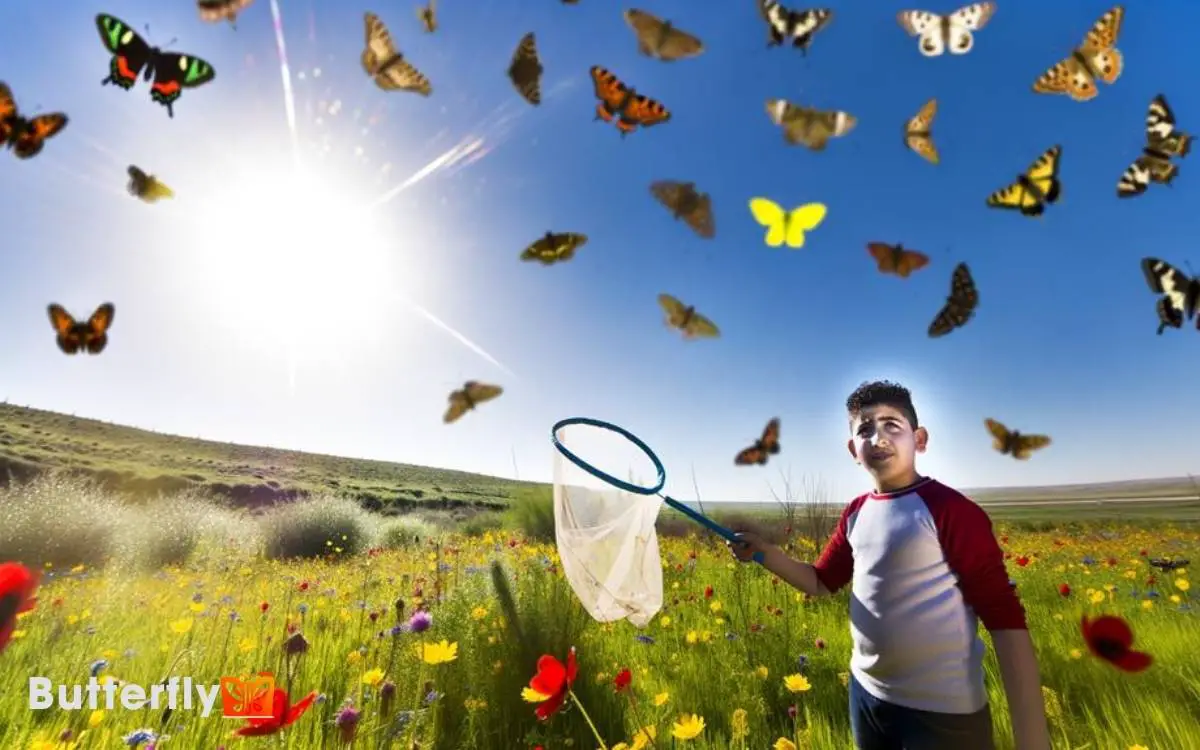How Can You Catch a Butterfly? Tips and Techniques!
To catch a butterfly, use a butterfly net with a long handle and soft, fine mesh. Choose warm, sunny days, preferably mid-morning to early afternoon when butterflies are most active. Head to meadows, gardens, or forest edges where there’s an abundance of nectar-rich flowers.
Position yourself downwind and approach slowly. Hold the net at a 45-degree angle and swiftly enclose the butterfly with an upward motion. Gently grasp its closed wings to avoid harm.
Release in a calm, sheltered area. By following these steps, you’ll catch butterflies without causing them stress or injury. Want more specifics about each step?

Key Takeaways
Choosing the Right Tools
To effectively catch a butterfly, you’ll need a few essential tools: a butterfly net, a field guide, and a collection container. Make sure your butterfly net has a long handle and a soft, fine mesh to avoid damaging delicate wings.
The field guide will help you accurately identify species, noting their distinctive markings and preferred habitats. A clear collection container with ventilation holes is crucial for temporary observation without causing stress to the butterfly.
Be meticulous in your approach: gently swoop the net over the butterfly, making sure to trap it without force. Transfer it to the container carefully, minimizing contact. These tools and methods will enhance your success rate and ensure the butterflies’ safety during the capture process.
Best Times to Catch Butterflies
Now that you have the right tools, you’ll find that the best times to catch butterflies are during warm, sunny days when they’re most active. Butterflies are ectothermic, relying on external heat to regulate their body temperature.
Aim to venture out mid-morning to early afternoon, as butterflies use these hours to bask in sunlight, warming their flight muscles for peak performance. Observationally, notice that peak activity often coincides with temperature ranges between 70-85°F (21-29°C).
Avoid early mornings or late afternoons; cooler temperatures reduce their activity. Additionally, windless conditions are preferable, as strong gusts can inhibit their flight.
Ideal Locations for Butterfly Catching
You’ll find that meadows, gardens, and forest edges provide the most ideal locations for butterfly catching due to their abundance of nectar-rich flowers and shelter. These environments attract a plethora of butterfly species, which thrive in such biodiverse habitats.
When scouting for butterflies, focus on areas with:
- Flower clusters: Species like the Monarch prefer milkweed, while Swallowtails are drawn to dill and fennel.
- Sunny spots: Butterflies are ectothermic and require sunlight to regulate their body temperature.
- Sheltered areas: Look for sites with minimal wind exposure, as butterflies seek calm conditions for feeding and resting.
Techniques for Safe Catching
Guaranteeing the safe capture of butterflies involves using a lightweight, fine-mesh net to minimize harm to their delicate wings.
Position yourself downwind and approach slowly. Hold the net’s handle at a 45-degree angle, anticipating the butterfly’s flight path. Gently sweep the net in a swift, upward motion, creating a soft enclosure.
Observe the butterfly’s behavior if it flutters, wait until it rests. Avoid sudden movements that might startle it. Once captured, close the net by twisting the handle, ensuring the butterfly is secured without pressure on its wings. Inspect the net’s interior for any entanglement.
Handle the net carefully to prevent any damage. This methodical approach guarantees minimal stress and injury to the butterfly.
Gentle Handling and Release
Gently grasp the butterfly by the closed wings between your thumb and forefinger, making sure minimal contact with its body to avoid damaging its delicate structures.
Carefully observe the butterfly for signs of stress or damage. Once you’ve assessed its condition, proceed to release it in a suitable environment.
To guarantee a safe release, follow these steps:
- Select a calm, sheltered area: Avoid windy or open spaces that could disorient the butterfly.
- Hold the butterfly close to vegetation: Position it near a flower or leaf where it can easily land and recover.
- Slowly open your fingers: Allow the butterfly to fly away at its own pace, minimizing sudden movements.
Conclusion
With the right tools, perfect timing, and ideal locations, you can successfully catch butterflies without harming them. Remember, it’s all about technique: approach quietly, move gently, and handle with care.
When you release them, you’re not just letting go of a butterfly you’re contributing to the delicate balance of nature.
Your methodical approach guarantees both the joy of catching and the responsibility of releasing, creating a beautiful dance between human curiosity and natural harmony.







D.bal.max helps you get huge muscular tissues by rising the protein synthesis, your strength, and testosterone.
Testogen pumps up your testosterone levels (thanks to the combo of pure ingredients).
If you need to achieve muscle mass and retain lean muscle
after your bulking part, this is the proper supplement for you.
You’ll see how these supplements may help you build physique you all the time wished and why is D-Bal the most
effective natural alternative to bodybuilding steroids.
Nicely, there are some supplements available on the
market that can really assist to “mimic” the effects of steroids, without really being one.
These legal steroids are NOT sold in GNC, Walmart, or Vitamin Shoppe,
but you CAN find them for sale on-line.
Packed together into bodybuilding supplements they can be stronger than you would ever dream.
Hello, I want that I have seen this website earlier than I bought the Ultimate Stack from Crazy Bulk.
Anyway, now I will attempt the merchandise for
a month and give the outcomes of both my strength/muscle progress
and fat loss. Second, although some of CrazyBulk’s supplements embrace some elements which are well-supported by
bodybuilding science, these ingredients’ dosages are far beneath the
typical suggestions. Nevertheless, the crucial downside is that none
of the supplements comprise wherever near the dosage ranges
recommended by weightlifting experts for constructing muscle
and aiding recovery. Whey protein is a well-liked ingredient in weightlifting supplements because it has a high content
of BCAA’s, which, according to Hickey, are the building blocks of our physique.
Usually, a cycle of authorized testosterone steroids lasts for two
months, followed by a break of 1.5 weeks
before resuming the next cycle. This break permits your physique to recover
and prevents the physique from becoming immune to the complement.
When using authorized testosterone steroids, it is essential to follow the beneficial dosage and cycle as specified by the producer.
It is advisable to purchase HBulk from the Brutal Force web
site to make sure product authenticity and high quality.
Using HBulk as part of a well-rounded fitness routine may help
you obtain your bodybuilding targets safely and effectively.
You can go for Crazy Bulk products instead since their steroid
various dietary supplements are designed to be stacked in different methods, depending on what you need to see.
Whether Or Not you must stack or not will rely upon what you are attempting
to do. You Have probably heard of injectable anabolic steroids and the
cream variations you’ll have the ability to apply to your skin. We do not advocate those as a end result of
they do not seem to be protected for long-term consumption.
Legal steroids are secure to make use of, so that you won’t expertise any dangerous side effects from the dietary
supplements we’ve discussed here.
When a good brand of authorized steroid options are taken the best
method, and their use is managed, they can be extraordinarily helpful.
If you are thinking of using steroids, don’t panic as they
are often very extraordinarily useful in certain conditions.
Legal steroids and muscle building supplements like Muscle Labs Dbol are primarily used
as weight gain drugs and anabolic bulking brokers.
We meticulously researched and analyzed various authorized steroids to select the most effective ones for weight lifting.
Analysis suggests that prohormone supplementation during
resistance training does not increase testosterone levels or boost muscle gain and will result in adverse well being consequences.
Delivery and dealing with for Dbal products are absolutely free inside the Usa and Uk.
Worldwide Dbal orders to other areas embody a flat $9.99 shipping payment, wherever on the earth.
Flat definitely means flat, the speed doesn’t go up for large bulk
orders. As to the bodily location, the Dbal merchandise are made in an FDA cGMP compliant manufacturing
unit. Each the factories and improvement laboratories
are inspected frequently by the FDA to ensure that all standards are
met, and that you are getting what the DBal says comes on the bottle label.
These are DBal supplements, which are not governed by FDA prescription schedules and regulations.
The first three D-bal ingredients are Isoleucine (100
mg), Valine (100 mg), and Leucine (25 mg). Each full bottle contains 90 drugs,
and these should last you for an entire month. Of course, you’ll save
more cash by buying Dbal in greater proportions.
Dianabol carries an inventory of dangerous and undesirable unwanted side
effects almost a mile long, tough authorized standing, and
an unacceptably excessive expense that maintain many weight lifters justifiably doubtful about its use.
In distinction, Vintage Muscle supplements are sold directly
to customers via their official web site in addition to on some on-line marketplaces.
The model has a presence on respected shopper review sites, although its exact industry certifications aren’t
specified within the supplied search results.
D.bal.max is for everybody who wants a good alternative to Dianabol (and don’t want to use D-BAL).
First Rate natural complement for bulking up; Ecdysterone has shown to ramp
up your lean muscle, strength, and even chip away at body
fats whereas preserving your thoughts sharp. If you are into muscle constructing and looking for alternate options to anabolic
steroids, you might have heard about pro-hormones, the cousins of anabolic steroids.
Once you take them, they transform into energetic steroid
hormones right inside your body. It Is like
they’re undercover agents that turn out to be superheroes as soon as they’re in. Plant-based steroids,
also called phytoesteroids or phytosteroids, could be useful for bodybuilding because of their
ability to mimic anabolic properties.
Whether you need assistance selecting the best legal steroid alternative, monitoring a
shipment, or initiating a refund, assistance is just a click on away.
When it comes to selecting a supplement model, nothing speaks louder than real-world outcomes.
CrazyBulk has built its reputation not simply on formulation but additionally on the consistent success stories of shoppers around the globe.
From first-time lifters to elite athletes, hundreds have turned to
CrazyBulk to assist them achieve their targets with out risking their well
being or violating drug rules.
It’s like watching Dianabol’s effects unfold, however without the liver
pressure or hormonal imbalances. I didn’t find any authorized steroid capsules
that used synthetic components in all of my research.
I’m referring to synthetic flavors, colors, and sweeteners, that don’t add any benefits
to the capsules. Generally, blended dietary supplements seem protected, with a low
threat of main unwanted effects.
Their effectiveness depends on appropriate use, coupled with
consistent exercise and a balanced diet. It’s also advisable to consult
a healthcare professional earlier than beginning any
new supplement routine. Steroids, once the forbidden fruit in sports and bodybuilding, have been around
longer than most understand. Initially, they had been completely within the realm of drugs, treating conditions
from anemia to chronic wasting. Fast ahead a few decades, and steroids are
a household name, however not all the time for the best reasons.
HyperGH14X can be used or stacked with any of the legal steroids I have mentioned, it is actually
universal. If you are trying to use just one complement for maximum gains,
D-Bal Max is your best bet.
References:
JBHNews